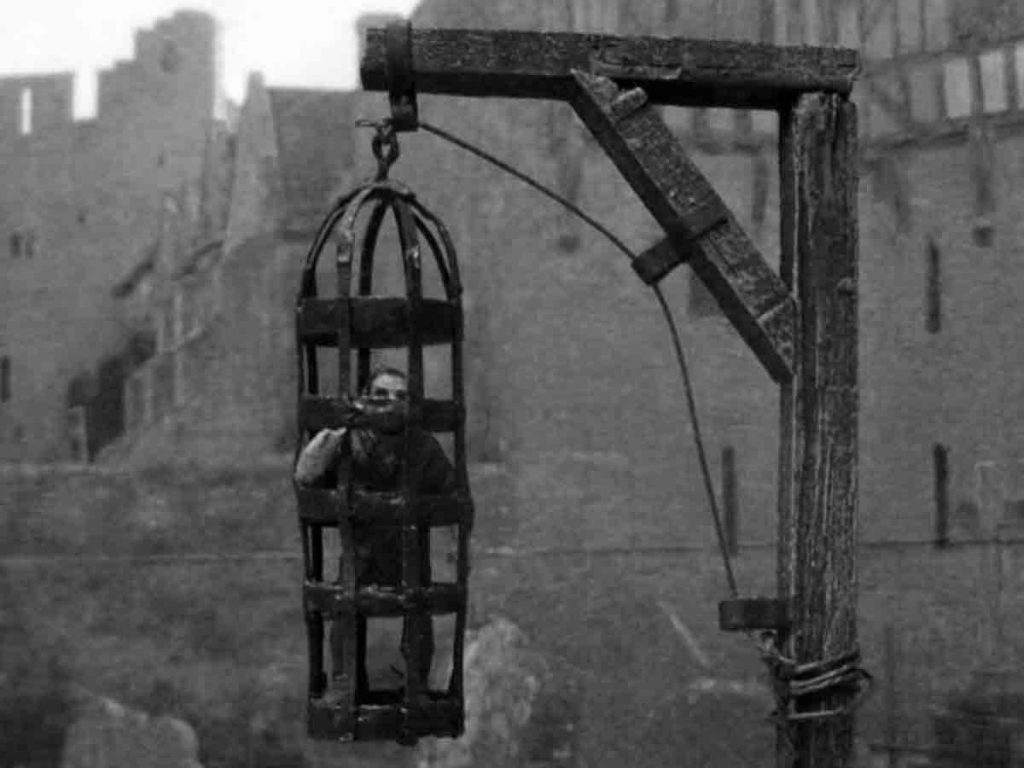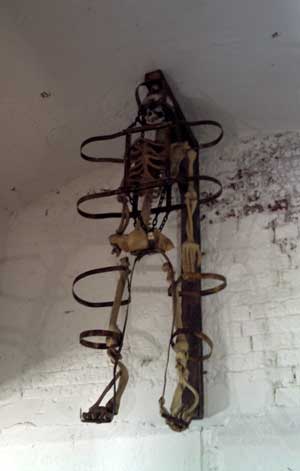Gibbeting refers to the act of suspending or hanging the body of a deceased person in an iron cage or framework, usually made of metal or wood. The torturous tale of the last live gibbeting in England is recounted by ELLIOT DAVIES

Gibbeting is a particularly inhuman form of execution from the old world that strikes me as one of the worst possible ways to die.
It involves being suspended outdoors in a body-hugging cage that utterly restricts all movement. There you’re left to the mercy of the crows and the cold. All who were put into a gibbet would leave a skeleton – the flesh having fallen from their bones, their tastiest bits having long since become carrion – perhaps whilst they still drew breath. Not pleasant.
We know of the last person to ever have been gibbeted alive. It happened in the 1830s in Baslow, directly east of the historic Chatsworth House in Derbyshire.
What is gibbeting?
Our story concerns a vagrant who, cold, tired, hungry and desperate, called into a thatched cottage in Baslow, begging for food. The lady of the house had just finished making breakfast, so the intoxicating scent of fried bacon filled the air. But she told the vagrant, in no uncertain terms, that there was no food for him.
Don’t worry, you’ll stop feeling sorry for this vagrant in a few seconds. Incensed, he forced his way into the house, overpowered the woman, and poured the boiling fat from the bacon directly down her throat. She was scalded to death, and he was promptly arrested and tried for murder. Not pleasant.
He was sentenced to be hung at Gibbet Moor, just off the Baslow/Chesterfield Road, to suffer a prolonged and agonising death.
As the unbearable pain of hunger, thirst, cold, exposure and muscle cramp set in, the vagrant began to scream. And scream. And scream. He screamed so loud and so long into the night that he woke the Duke of Devonshire who was, at the time, staying at the nearby Chatsworth House.
The Duke was so disturbed by the screams that he enacted laws to prohibit the awful act of gibbeting. The vagrant was thus the last person to ever die by gibbeting in England. His name is unfortunately lost forever, but some say that his screams can still be heard up at Gibbet Moor.

Hiker reports ghostly screams from the gibbet
In 1992, a hiker by the name of Jane Townsend reported to have heard these unearthly, horrifying screams, yet this sad tale apparently created two ghosts. The vagrant’s uncharitable and unfortunate victim reportedly sits at the bedside in the master room of her cottage.
The late Edgar Osbourne, a Chatsworth House archivist, even claimed to have been soothed by this spirit when bedridden by illness. Is she giving the charity which, when refused in her life, caused her death?
This undeniably tragic tale left its mark on the land in the form of one spirit condemned to endless torment, another obliged to offer endless charity and, above all, in the ultimate prohibition of the inhuman practice of gibbeting.
Background on Gibbeting
Gibbeting is an ancient and humiliating form of public execution, where the victim is hanged from a gibbet cage, dangling from a large erect wooden post. Gibbets were similar to gallows, however, the victim was not dead when they were hanged from it.
Gibbetting refers to an act in which a person is gibbeted. It usually involved leaving the victim on the gibbet to die and rot. In ancient England, it was called “Hanging in Chains”.
History of Gibbetting in England
The earliest gibbet in England is believed to have been erected in Halifax, West Yorkshire in the 16th century. However, it did not become common in England until the 18 century.
While gibbeting hit its peak in 1740, it was not officially mandated as a form of execution by the British Parliament until the Murder Act of 1752. This allowed the body of convicted murderers to be dissected publicly or to be gibbeted.
As a result of the Murder Act, over 130 men were reported to have been gibbeted between the years 1752 and 1832. (In England, it was usually only men who were gibbeted, because the medical world were always eager to dissect women.)
During those days, when a gibbet was erected, it usually attracted an excited and rowdy crowd of people ready to witness the spectacle. However, for those living near the gibbet, they had to contend with the repellent smell of rotting corpses which were left to decay for days, weeks or even years.
The law allowing gibbeting was repealed in 1834.
Types of gibbets
Dule or Dool tree
Dule trees were used as gallows for public execution and also as gibbeting corpses. These trees were found in prominent areas such as crossroads. Bodies were hung on these trees to serve a deterrent for others.
The words Dule or Dool have a Scottish origin, meaning sorrow of grief. Dule trees are sometimes called the “trees of lamentation”, it is also regarded as a “tree mourning”.
Sycamores were the most common Dule tree.
Cassillis Castle, South Ayrshire, had a Dule tree, but it was pulled down in winter of 1940. John Faa, the King of the Gypsies, was said to have been hanged together with his supporters from the Dule Tree at Cassilis. Other places Dule trees are said to be found at Douglas Castle in Lanarkshire and Leith Hall in Aberdeenshire.
Pillory
Pillories are a wooden structure with holes to hold an offender’s head and hands. They were used for keeping offenders imprisoned and were usually subjected to physical abuse publicly. The pillories were often at crossroads, market places, and other public areas. From 1816, the use of the pillory was limited to those convicted of perjury and subornation. They were used infrequently until 1872 when pilloring was abolished. The last person to be pilloried in England was Peter James Bossy.
Stocks
Stocks were restraining devices similar to pillories, designed for corporal punishment and public humiliation or shaming. It is a wooden board with hinges. It is used for restraining the feet and it is considered as one of the cruelest forms of torture in primitive days. In England in the 14th century, it was prescribed by the Statute of Labourers for unruly artisans. It’s believed to have been used in the UK in the 19th century.
Gallows
Gallows, also known as scaffolds, are wooden frames used for execution. In ancient times, they were usually large and found in public places like the market square.
Temporary Gallows could be moved from one place or location to another. In England, Pirates were usually executed using temporary gallows. One of such people killed was James Aitken, also known as John the Painter. He was executed in 1777 on a frigate ship in Portsmouth for arson.
List of who was gibbeted in England
Here are some of the people who were gibbeted in England.
- Andrew Burnet and Henry Payne in 1744 in Gloucestershire.
- Walter Kidston in 1773 in Gloucestershire.
- Philip Hooton in 1769 in Lincolnshire.
- George Combes in 1786 at Boar Ness Point, Kent.
- Gill Smith in 1738 in Kennington, London.
The last two men to be gibbeted in England were William Jobling and James Cook in 1832.
Where can gibbets be found in England?
Most gibbets used in England no longer than exist, but here are some places you can still see them:
- The Combe Gibbet, Hungerford
- The Gibbet Hill Wood, Coventry
- The Steng Cross Gibbet, Northumberland (also known as Winter’s Gibbet)
- The Busby Stoop Inn, North Yorkshire
- Execution Dock, Wapping, East London (read about nearby Prospect of Whitby pub)
- Halifax Gibbet, Halifax, West Yorkshire
- Caxton Gibbet, Cambridgeshire
- The Cage of John Breads’ Gibbet, East Sussex
- The Millom Gibbet, Cumbria
- The Brigg Gibbet, Lincolnshire








You say it’s the last, then don’t print the year the gibbeting occurred? Seriously?
She should have fed the poor soul.
Lol so the guy who didn’t get his way and poured grease down her throat is the actual victim!? Wow
Some say the smell of ye olde bacon stealths the gibbet moors to this day, fo soothe